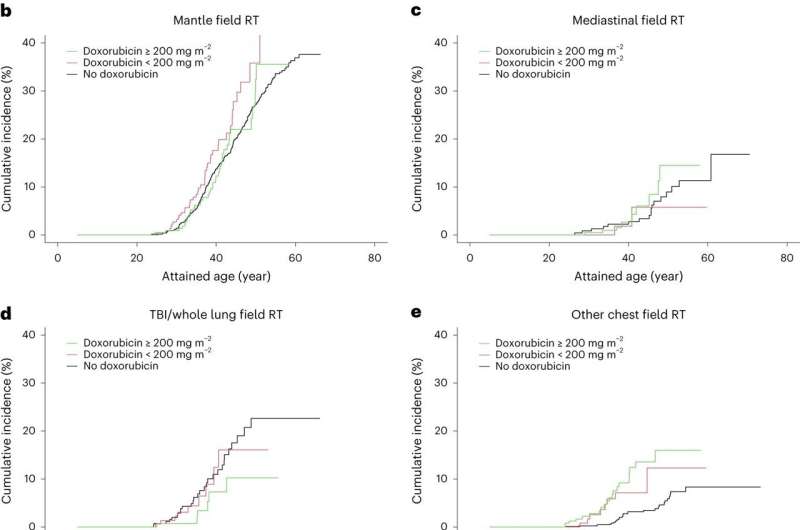This article has been reviewed according to Science X's editorial process and policies. Editors have highlighted the following attributes while ensuring the content's credibility:
fact-checked
peer-reviewed publication
proofread
Study finds higher breast cancer risk after certain forms of childhood cancer treatment

Three out of four children with cancer are successfully treated and survive the disease. But the treatment, which often consists of a combination of surgery, chemotherapy and radiation, can cause serious side effects and late effects in some survivors. One of those late effects is developing a second cancer in adulthood.
In a new study, scientists from the Princess Máxima Center investigated the risk of breast cancer in women who were treated for childhood cancer with so-called anthracycline chemotherapy, including doxorubicin. They looked at the medical records of nearly 18,000 childhood cancer survivors treated between 1946 and 2012 in the Netherlands, France, the United States and Switzerland. The study results were published in Nature Medicine.
Clearly increased risk
An international team of researchers, led by group leader Prof Dr. Leontien Kremer and Dr. Jop Teepen, found that 782 of all 17,903 survivors in the study were later diagnosed with breast cancer. The scientists analyzed which forms of treatment were linked to the later occurrence of breast cancer.
Women treated with high-dose doxorubicin, without radiation to the chest, had an almost six-fold greater risk of breast cancer before the age of 40 (3.4%) than women in the general population (0.6%). The small group of women who had both radiation to the chest and a high dose of the chemotherapy doxorubicin as a child had the highest risk of later breast cancer. In that group, the estimated risk of breast cancer before the age of 40 was 8.1%.
Screening for breast cancer
From five years after diagnosis, children and adults who have been treated for childhood cancer visit the LATER outpatient clinic of the Princess Máxima Center. There, they are monitored for possible late effects of treatment, including developing a second cancer. Based on the new results, the researchers are calling for broadening the guidelines for breast cancer screening in childhood cancer survivors.
Yuehan Wang, a member of the Kremer group at the Princess Máxima Center for pediatric oncology, worked on the study as part of her Ph.D. research. She says, "Anthracyclines are still an important part of the treatment for more than half of children with cancer. The dose that is now prescribed is on average much lower than in the past, but there are still children who need a high dose of these drugs in their treatment."
"We have known for some time that anthracyclines can be harmful to the heart, so the importance of keeping the dose of this type of chemotherapy low was already clear. Developing a second cancer is a rare but serious late effect of childhood cancer treatment. Our results underline the need to reduce the dose of doxorubicin in children whenever possible."
Prof Dr. Leontien Kremer, research group leader at the Princess Máxima Center for pediatric oncology, who led the study, says, "We work hard to make treatment for children with cancer more effective, and to improve the quality of life during and after treatment. In our research we saw that the majority of survivors fortunately do not get breast cancer at a young age. But a number of patient groups have a higher risk of developing breast cancer."
"Women who received chest radiotherapy as a child are screened for breast cancer from the age of 25, because it was already known that they are at an increased risk. Based on these new results, we aim to expand international guidelines for breast cancer screening, so that women who received a high dose of doxorubicin are also screened early."
More information: Wang, Y. et al, Subsequent female breast cancer risk associated with anthracycline chemotherapy for childhood cancer, Nature Medicine (2023). DOI: 10.1038/s41591-023-02514-1. www.nature.com/articles/s41591-023-02514-1


















